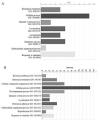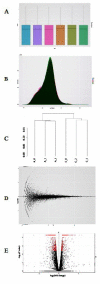Transcriptomic Changes in the Rumen Epithelium of Cattle after the Induction of Acidosis
- PMID: 32292009
- PMCID: PMC8410162
- DOI: 10.22092/ari.2019.125930.1326
Transcriptomic Changes in the Rumen Epithelium of Cattle after the Induction of Acidosis
Abstract
The transition from normal forage to a highly fermentable diet to achieve rapid weight gain in the cattle industry can induce ruminal acidosis. The molecular host mechanisms that occur in acidosis are largely unknown. Therefore, the histology and transcriptome profiling of rumen epithelium was investigated in normal and acidosis animals to understand the molecular mechanisms involved in the disease. The rumen epithelial transcriptome from acidosis (n=3) and control (n=3) Holstein steers was obtained using RNA-sequencing. The mean values of clean reads were 70,975,460±984,046 and 71,142,189±834,526 in normal and acidosis samples, respectively. In total, 1,074 differentially expressed genes were identified in the two groups (P<0.05), of which 624 and 450 genes were up- and down-regulated in the acidosis samples, respectively. Functional analysis indicated that the majority of the up-regulated genes had a function in filament organization, positive regulation of epithelial and muscle fiber concentration, biomineral tissue development, negative regulation of fat cell differential, regulation of ion transmembrane transport, regulation of cell adhesion and butyrate, as well as short-chain fatty acid absorption that was metabolized as an energy source. Functional analysis of the down-regulated genes revealed effects in immune response, positive regulation of T-cell migration, regulation of metabolic processes, and localization. Furthermore, the results showed a differential expression of genes involved in the Map Kinase and Toll-like receptor signaling pathways. The IL1B, CXCL5, IL36A, and IL36B were significantly down-regulated in acidosis rumen tissue samples. The results suggest that rapid shifts to rich fermentable carbohydrates diets cause an increase in the concentration of ruminal volatile fatty acids, tissue damage, and significant changes in transcriptome profiles of rumen epithelial.
Keywords: Acidosis; Cattle; Ruminal epithelial tissue; Transcriptome.
Copyright © 2020, Archives of Razi Institute. Published by Kowsar.
Conflict of interest statement
The authors declare that they have no conflict of interest.
Figures





References
-
- Alston JM, Pardey PG. Agriculture in the global economy. J Econ Perspec. 2014; 28: 121–146.
-
- Blanch M, Calsamiglia S, Devant M, Bach A. Effects of acarbose on ruminal fermentation, blood metabolites and microbial profile involved in ruminal acidosis in lactating cows fed a high-carbohydrate ration. J Dairy Res. 2010;77(1):123–8. - PubMed
-
- Dionissopoulos L, AlZahal O, Steele MA, Matthews JC, McBride BW. Transcriptomic changes in ruminal tissue induced by the periparturient transition in dairy cows. Am J Anim Vet Sci. 2014;9(1):36–45.
Publication types
MeSH terms
LinkOut - more resources
Full Text Sources
Medical
